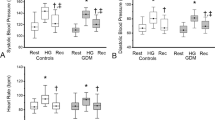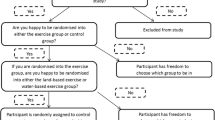Abstract
Introduction
In formerly preeclamptic women with a low plasma volume, the recurrence rate of preeclampsia is higher than in women with a normal prepregnant plasma volume. In a recent study, we demonstrated that the low plasma volume subgroup also had a subnormal venous capacitance. In the present study, we determined the impact of subnormal plasma volume on the hemodynamic response to moderate exercise.
Patients and Methods
We performed this study in the follicular phase of the menstrual cycle, in 31 formerly preeclamptic women with a subnormal plasma volume (low-PV) and eight parous controls. The exercise consisted of 60 minutes of cycling in the supine position at 35% of the individualized maximum capacity. Before, during, and after cycling, we measured the percentage change in heart rate, stroke volume, and cardiac output. Before and after exercise, we measured the effective renal plasma flow (ERPF, para-amino-hippurate [PAH] clearance), glomerular filtration rate (GFR, inulin clearance), circulating levels of alpha-atrial natriuretic peptide (α-ANP), and active plasma renin concentration (APRC).
Results
The response to exercise of formerly preeclamptic women with a subnormal plasma volume differed from that in controls by a lack of rise in stroke volume, a smaller rise in cardiac output and a-ANP, and a greater fall in GFR. The responses in heart rate, ERPF, and APRC did not differ between the two groups.
Conclusion
The response to moderate exercise of formerly preeclamptic women with a subnormal plasma volume differs from that in healthy parous controls with a normal plasma volume and suggests a lower capacity to raise venous return in conditions of a higher demand for systemic flow. The lower capacity to raise venous return in these conditions is associated with more cardiovascular drift. The physiologic consequence is a lower aerobic endurance performance during moderate exercise.
Similar content being viewed by others
References
Spaanderman ME, Ekhart TH, van Eyck J, Cheriex EC, de Leeuw PW, Peeters LL. Latent hemodynamic abnormalities in symptom-free women with a history of preeclampsia. Am J Obstet Gynecol 2000;182:101–7.
Aardenburg R, Spaanderman ME, Ekhart TH, van Eijndhoven HW, van der Heijden OW, Peeters LL. Low plasma volume following pregnancy complicated by pre-eclampsia predisposes for hypertensive disease in a next pregnancy. BJOG 2003;110:1001–6.
Goodlin RC. Maternal plasma volume and disorders of preg-nancy. Br Med J 1984;288:1454–5.
Silver HM, Seebeck M, Carlson R. Comparison of total blood volume in normal, preeclamptic, and nonproteinuric gestational hypertensive pregnancy by simultaneous measurement of red blood cell and plasma volumes. Am J Obstet Gynecol 1998;179:87–93.
Bernstein IM, Meyer MC, Osol G, Ward K. Intolerance to volume expansion: A theorized mechanism for the development of preeclampsia. Obstet Gynecol 1998;92:306–8.
Hunyor SN. Vascular, volume, and cardiac response to normal and hypertensive pregnancy. Hypertension 1984;6:III129–32.
Hays PM, Cruikshank DP, Dunn LJ. Plasma volume determination in normal and preeclamptic pregnancies. Am J Obstet Gynecol 1985;151:958–66.
Barr SI. Effects of dehydration on exercise performance. Can J Appl Physiol 1999;24:164–72.
Fortney SM, Wenger CB, Bove JR, Nadel ER. Effect of blood volume on forearm venous and cardiac stroke volume during exercise. J Appl Physiol 1983;55:884–90.
Coyle EF, Gonzalez-Alonso J. Cardiovascular drift during prolonged exercise: New perspectives. Exerc Sport Sci Rev 2001;29:88–92.
Report of the National High Blood Pressure Education Program Working Group on High Blood Pressure in Pregnancy. Am J Obstet Gynecol 2000;183:S1–S22.
Spaanderman M, Ekhart T, van Eyck J, de Leeuw P, Peeters L. Preeclampsia and maladaptation to pregnancy: A role for atrial natriuretic peptide? Kidney Int 2001;60:1397–406.
van Kreel BK, van Beek E, Spaanderman ME, Peeters LL. A new method for plasma volume measurements with unlabeled dex-tran-70 instead of 1251-labeled albumin as an indicator. Clin Chim Acta 1998;275:71–80.
Wesseling KH, de Wit B, Weber JAP, Smith NT. A simple device for the continuous measurement of cardiac output. Its model basis and experimental verification Adv Cardiovasc Phys 1983;5 Suppl 11:16–52.
Jansen JR, Wesseling KH, Settels JJ, Schreuder JJ. Continuous cardiac output monitoring by pulse contour during cardiac surgery. Eur Heart J 1990;11 Suppl 1:26–32.
Stok WJ, Baisch F, Hillebrecht A, Schulz H, Meyer M, Kare-maker JM. Noninvasive cardiac output measurement by arterial pulse analysis compared with inert gas rebreathing. J Appl Physiol 1993;74:2687–93.
Gratz I, Kraidin J, Jacobi AG, deCastro NG, Spagna P, Larijani GE. Continuous noninvasive cardiac output as estimated from the pulse contour curve. J Clin Monit 1992;8:20–7.
Aardenburg R, Spaanderman ME, Courtar DA, van Eijndhoven HW, de Leeuw PW, Peeters LL. A subnormal plasma volume in formerly preeclamptic women is associated with a low venous capacitance. J Soc Gynecol Investig 2005;12:107–11.
Courtar DA, Janssen BJ, Peeters L, Spaanderman M. A low plasma volume in formerly preeclamptic women is associated with sympathetic hyperactivity. J Soc Gynecol Investig 2004; 12(2 Suppl):123a.
Poortmans JR. Exercise and renal function. Sports Med 1984;1:125–53.
Taverner D, Craig K, Mackay I, Watson ML. Effects of exercise on renal function in patients with moderate impairment of renal function compared to normal men. Nephron 1991;57:288–92.
Guyton AC, Douglas BH, Langston JB, Richardson TQ. Instantaneous increase in mean circulatory pressure and cardiac output at onset of muscular activity. Circ Res 1962;431:431–41.
Green way CV, Lautt WW. Blood volume, the venous system, preload, and cardiac output. Can J Physiol Pharmacol 1986;64:383–7.
Flamm SD, Taki J, Moore R, et al. Redistribution of regional and organ blood volume and effect on cardiac function in relation to upright exercise intensity in healthy human subjects. Circulation 1990;81:1550–9.
Rothe CF. Reflex control of veins and vascular capacitance. Physiol Rev 1983;63:1281–342.
Roy BD, Green HJ, Grant SM, Tarnopolsky MA. Acute plasma volume expansion alten cardiovascular but not thermal function during moderate intensity prolonged exercise. Can J Physiol Pharmacol 2000;78:244–50.
Nose H, Mack GW, Shi XR, Morimoto K, Nadel ER. Effect of saline infusion during exercise on thermal and circulatory regulations. J Appl Physiol 1990;69:609–16.
Convertino VA. Blood volume: Its adaptation to endurance training. Med Sci Sports Exerc 1991;23:1338–48.
Spaanderman ME, Willekes C, Hoeks AP, Ekhart TH, Peeters LL. The effect of pregnancy on the compliance of large arteries and veins in healthy parous control subjects and women with a history of preeclampsia. Am J Obstet Gynecol 2000;183:1278–86.
Bosio PM, McKenna PJ, Conroy R, O’Herlihy C. Maternal central hemodynamics in hypertensive disorders of pregnancy. Obstet Gynecol 1999;94:978–84.
Author information
Authors and Affiliations
Corresponding author
Rights and permissions
About this article
Cite this article
Aardenburg, R., Spaanderman, M.E., van Eijndhoven, H.W. et al. Formerly Preeclamptic Women With a Subnormal Plasma Volume Are Unable to Maintain a Rise in Stroke Volume During Moderate Exercise. Reprod. Sci. 12, 599–603 (2005). https://doi.org/10.1016/j.jsgi.2005.08.005
Published:
Issue Date:
DOI: https://doi.org/10.1016/j.jsgi.2005.08.005




